Does a Safer Car Mean Lower Insurance Premiums?

Auto manufacturers are always looking for ways to make their vehicles safer, and they use the latest technology to lower the risk and consequences of an accident. Some insurance providers have taken note of these developments and may offer lower premiums as a result.
But does a safer car automatically mean lower insurance premiums? And how do some of these features help reduce risk? Keep reading to find out.
Can You Get Lower Insurance Premiums by Driving a Safer Car?
Yes, many insurance providers will give you a discount if you drive a car fitted with certain safety features. However, these rates will vary depending on the provider and your vehicle type.
What Do the Facts Say About Collision Avoidance Systems and Safe Driving?
Insurance companies have a good reason for offering discounts, as these safety features make a difference. According to the Insurance Institute for Highway Safety, a forward collision warning system can help reduce the number of front-to-rear crashes by 27%. Lane departure warnings may help to lower the prevalence of single-vehicle, sideswipe, and head-on crashes by 11%.
How Does Collision Mitigation Technology Reduce the Risk of a Fatal Accident?
Some collision mitigation techniques can reduce your risk of being involved in a fatal accident. According to one study, vehicles fitted with a lane departure warning system had an 86% lower involvement rate in crashes with fatalities. This feature alerts the driver with a vibration when the car strays from its lane. It works particularly well should a driver nod off on a multilane highway.
What Features Can Lower Car Insurance Rates?
Numerous auto safety features can lower your car insurance rates, including:
- Collision warning and blind spot detection
- Adaptive cruise control
- Lane keep and lane departure warnings
- Adaptive headlights
VinFast Cars and Safety Features
VinFast builds its cars to protect you. They feature a full range of active and passive safety features, such as driver-assist technology and a heads-up display. However, it’s important to remember that these features are still no substitute for being an alert defensive driver.
But what do you think? Do you believe that these features make you a better and safer driver? Do you think insurance companies should give you a steeper discount for driving a much safer car? Let me know in the comments below.
Bạn cần đăng nhập để tương tác với nội dung này: Đăng nhập.



